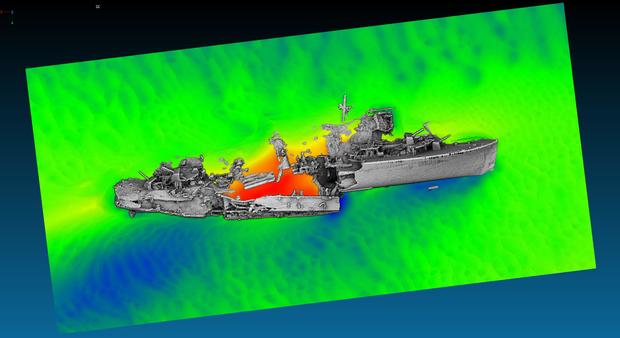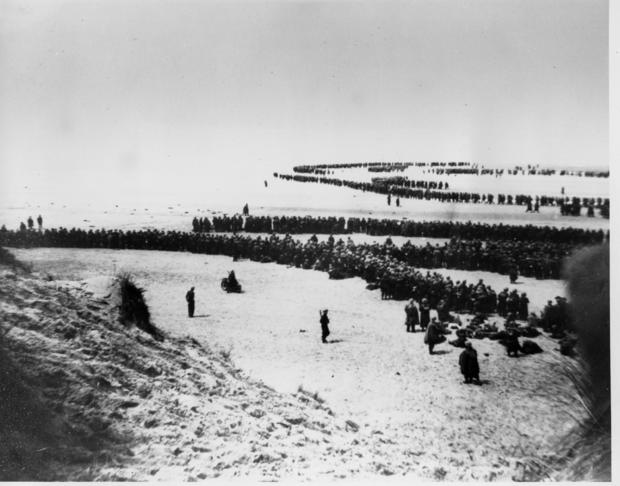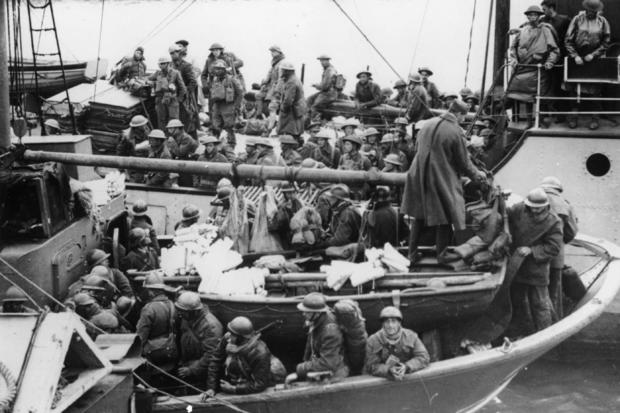Dozens of WWII shipwrecks from Operation Dynamo identified in Dunkirk channel: "It's quite an emotional feeling"
Shattered by bomb impacts, the 100-meter-long British destroyer "Keith" has been lying at the bottom of the Dunkirk channel since its sinking in 1940.
It went down during Operation Dynamo, when hundreds of thousands of Allied troops were rescued by sea from the advancing Germans.
Now the World War II warship appears in brightly colored 3D, vertical slice by vertical slice, on the screen of Mark James, a geophysicist from Historic England.
James has joined a group of archaeologists taking stock of the traces of the battle still lurking under the waves.
A British government agency, Historic England has joined the search for wrecks dating to the Dunkirk evacuation run by France's DRASSM, which is in charge of underwater archaeology.
Firing sound waves down to the seabed, a multibeam sonar "allows us to create a really nice 3D model of the seabed and any wrecks and debris," he said.
"It's quite an emotional feeling seeing somebody's wreck come up on the screen," he added. "You kind of realize the human sacrifice that was made."
Although a large ship, the "Keith" is set to "disappear bit by bit," said Cecile Sauvage, an archaeologist with DRASSM who is one of those leading the search launched on September 25.
Surveying the wrecks now will allow both countries to "preserve the memory of these ships and the human history behind these wrecks", she added.
"Miracle of deliverance"
Brought to the big screen in an acclaimed 2017 film by Christopher Nolan, Operation Dynamo ran from May 26 to June 4, 1940.
Encircled in northern France by Nazi German forces, the Allies threw everything into a mass evacuation.
Over those nine days, 338,220 soldiers -- mostly British, but also 123,000 French and 16,800 Belgians -- were evacuated on all kinds of vessels, cramming into military ships, fishing trawlers, ferries and tugboats.
Winston Churchill, who had been British prime minister for just 16 days when the evacuation began, called it a "miracle of deliverance" in his famed "We Shall Fight on the Beaches" speech in 1940, the BBC reported.
The shortest route from Dunkirk to safe harbor across the English Channel in Dover is 40 miles.
But that path was within range of German guns already in place at Calais.
"Between 1,000 and 1,500 vessels of all types made the crossing", with 305 sunk by "shelling, enemy torpedoes, mines and even collisions caused by the panic around the operation," said archaeologist Claire Destanque, another of the search mission chiefs.
Almost 5,000 of the fleeing soldiers were drowned, according to Dunkirk-based historian Patrick Oddone.
"It's very moving"
The three-week search by two archaeologists and two geophysicists has quartered the English Channel to tally up the lost ships -- the first hunt of its kind in French waters.
Volunteer divers had already catalogued the locations of the wrecks, with the scientists' job to confirm the sites and shore up their identifications by comparing them with archive data.
Sailing on from the "Keith" under the autumn sun, the crew next heads for a French cargo ship, also around yards along the keel.
The "Douaisien" had made the trip from Algeria to unload its goods at Dunkirk before being requisitioned to transport 1,200 soldiers.
It had barely left the port before it hit a mine and sank, Claire Destanque recounts.
She points out the point the mine struck on the sonar screen, still visible more than 80 years later.
"Knowing the history that's behind it, it's very moving," she says.
The campaign has allowed the archaeologists to definitively identify 27 Operation Dynamo wrecks. Three more have been found, but need closer inspection by divers next year given the extent of the damage.
Historic England said another "19 features have been studied, three of which appear to correspond to the location and characteristics of vessels lost during Operation Dynamo that were previously undiscovered."
Sauvage says their aim has been "to better locate and get to know the remnants", as well as "to protect them better, especially if there's a construction plan like a wind farm that could destroy them".
Plans have been afoot for several years to build turbines in the sea off Dunkirk.
Another benefit of the search is the return to the headlines of "an important milestone" in World War II history that is far less familiar to the French public than in Britain, Sauvage adds.
The sunken wrecks represent "305 stories within the sweep of history," Destanque believes.
Dr. Antony Firth, the head of marine heritage strategy, told the BBC that some of the ships were heavily loaded with troops, and would have sunk "within minutes" with many lives lost.
"Undoubtedly a lot of people were wrapped up in Dunkirk. Most of them survived, got back to the U.K. and carried on their seafaring histories, and that's obviously very good," Firth told the BBC. "For some people, their family stories had a catastrophic element at Dunkirk, and that, I know for certain, still resonates with people today."






